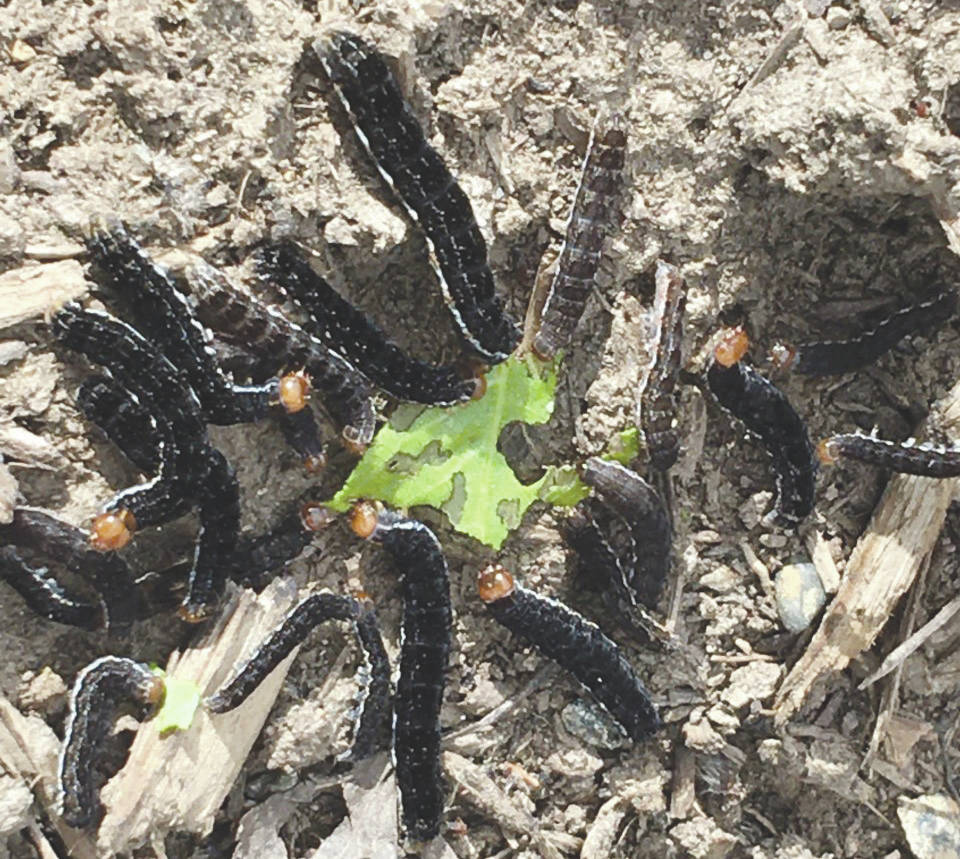In early June, I received multiple accounts of abundant black caterpillars stripping trees and shrubs of foliage around the Marsh Lake Trail off of Skilak Lake Road.
Later, I received word that dark caterpillars in notable numbers had been seen from Cooper Landing to Sterling and Kasilof. These larvae consumed leaves of aspen, highbush cranberry, birch, willows, roses, soapberry and almost any other broad-leaved plant.
Two people brought me live caterpillars from the Marsh Lake Trail area. My kids and I kept these in Kerr canning jars on my desk and fed them aspen leaves, hoping to rear them to adulthood so that they could be identified.
I also sent photos of the caterpillars to other entomologists in the state. Steve Swenson of the U.S. Forest Service tentatively identified them as caterpillars of the battered sallow moth, Sunira verberata.
The caterpillars in my canning jars turned into pupae in late June. Last weekend adults emerged. Steve was right. They were battered sallow moths.
We periodically see outbreaks of these caterpillars in southern Alaska. The last time they were abundant was in 2017, when they were seen in numbers along the Richardson Highway, in the Mat-Su, Anchorage and the Kenai Peninsula.
The caterpillars were eating cottonwoods, aspens, alders, willows, raspberries and even rhubarb. They in turn were being eaten by at least one puppy.
The dark larvae were even showing up conspicuously on sidewalks, sides of houses and other man-made structures.
The largest recorded outbreak of battered sallow moth caterpillars happened over 2003 to 2006 on the Alaska Peninsula, when up to 20,000 acres of alders and willows were damaged per year. We know that this outbreak was at least partly caused by battered sallow moths, but speckled green fruitworm moths, a closely related and similar caterpillar, may also have been involved.
That Alaska Peninsula outbreak was severe enough to kill alders on mountain slopes over large areas. Deciduous trees and shrubs and trees, like alders and willows, can usually withstand multiple years of their leaves being consumed without suffering lasting damage, so the severity of that 2003 to 2006 event was notable.
A U.S. Department of Agriculture Agricultural Research Service report noted what must have been a high population of battered sallow moths eating highbush cranberry and cultivated crops in Alaska in 1976.
Interestingly, although the battered sallow moth naturally occurs from Alaska to central Canada and south to Colorado, there is no record of outbreaks of this species outside of Alaska. I wonder why battered sallow moths become so abundant in Alaska but nowhere else.
I would also like to know what drives their cycle of abundance. A Forest Service report linked the 2003 to 2006 outbreak to higher than normal temperatures, but we really do not have enough information yet to explain why higher temperatures might lead to increased numbers of these caterpillars.
The battered sallow is not a well-studied animal. We did not even have good photographs of the caterpillars of this species until the recent 2017 outbreak. Most of the information about its food plants are from the recent Alaska outbreak events.
As with other forest caterpillars with periodic cycles of abundance, declines are likely caused mainly by diseases and parasites that pass through the populations. I failed to find any records of parasites, predators or diseases of the battered sallow moth.
In related moths, outbreaks are often ended by “zombie viruses” that rapidly sweep through dense caterpillar populations. The virus alters the caterpillars’ behavior, causing them to stop feeding and climb to the tops of trees.
There the caterpillars die and disintegrate, spreading virus particles over the foliage below, where they can be eaten by other caterpillars. In some species the infected cadavers become attractive to other caterpillars, which cannibalize them and then become “zombie caterpillars” themselves.
At least one other sallow moth species is attacked by short-tailed ichneumon wasps. Upon finding a mature caterpillar, the female wasp deposits an egg into it. A wasp larva develops inside the caterpillar, finally maturing and killing its host during the moth’s pupa stage.
Right now our battered sallow moth caterpillars have dropped to the ground to become pupae. The adults should be emerging from late July into the fall, presumably laying eggs in the fall.
The life history of this species has not been worked out, so we do not know when the eggs hatch and larvae begin feeding. The larvae may hatch in the fall, feed and grow some, then overwinter as small caterpillars. Alternatively, the eggs may hatch in early spring. We do know that the caterpillars are out by the beginning of June.
I will be paying attention to what happens in the woods on the Kenai Peninsula this year and next. In general, we would expect trees and shrubs to recover quite well from this year’s damage unless there are high numbers of caterpillars consuming much of the leaves for multiple years.
Matt Bowser serves as Entomologist at Kenai National Wildlife Refuge. Find more Refuge Notebook articles (1999–present) at https://www.fws.gov/refuge/Kenai/community/refuge_notebook.html.
By MATT BOWSER
Kenai National Wildlife Refuge

